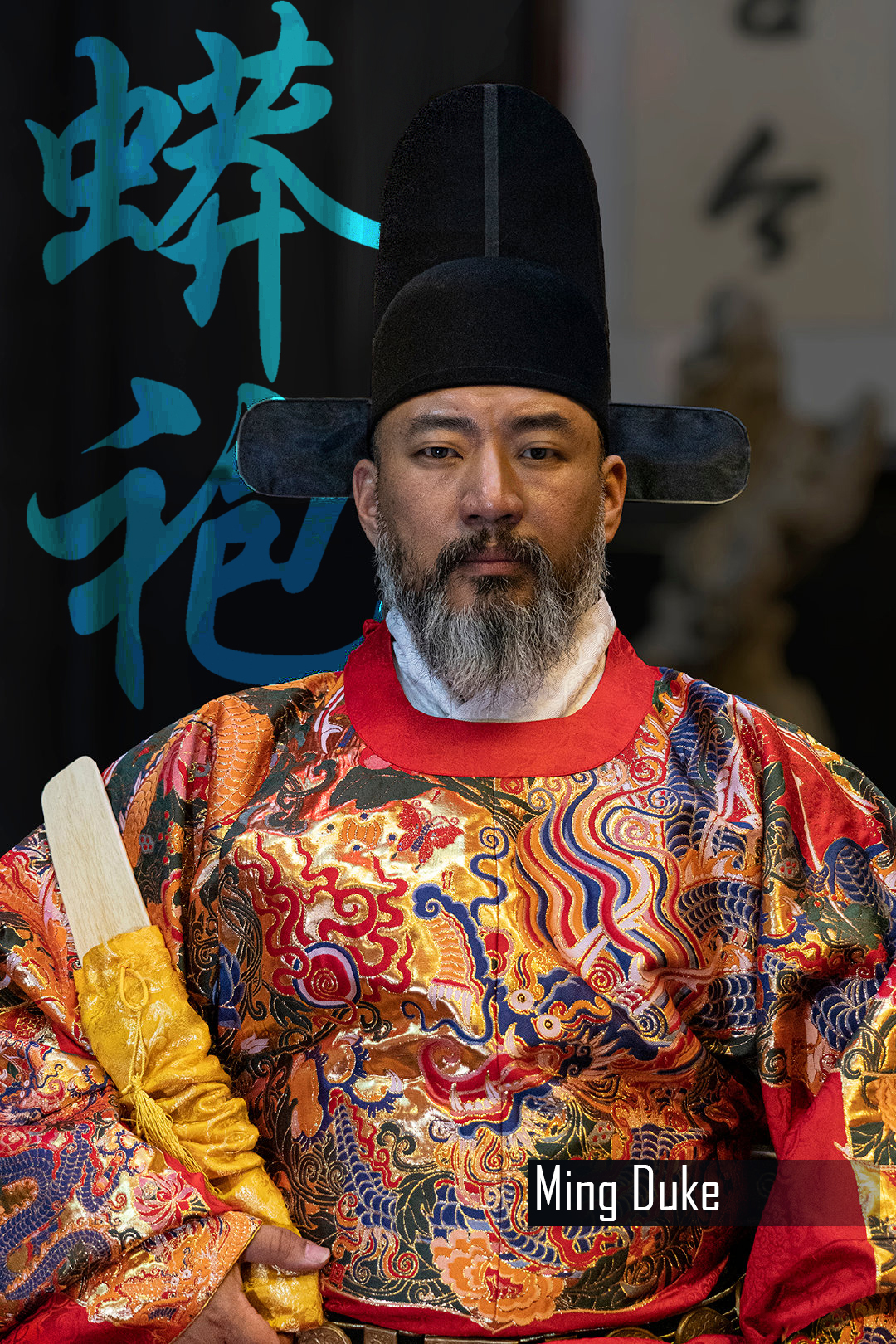Song Dynasty Ministers: 宋朝官臣
Music: 《梅花三弄》Winter Plum Blossoms
An assembly of Song ministers, they are distinguished by their vermilion silk court robes, and most of all, their black Zhanjiao Putou 展角幞头 (lit. "Horned Head Cover") official's hat.
Zhanjiao Putou 展角幞头 (lit. "Horned Head Cover")- perhaps the quintessentially most distinctive piece of headware that is emblematic of the Song dynasty, since the wearing of this distinctive form of hat was pegged mostly with this dynasty (and some overlap in the ensuing Yuan dynasty.) Putou simply means headscarf or headwrap, and was seen as far back in Chinese history as the Northern and Southern dynasties, mostly worn by the steppe and Central Asian influenced Northern Chinese polities.
Often, the strap that fastened the headscarf to the hearer's long tufted hair would be left flowing and stream in the wind. They were commonly worn by Chinese men of all social stratas. But in upper circles, such as that of the imperial court, such hats became even more elaborate. Portraits and classical depictions of Tang emperors and officials often depicted them wearing a stylized version of official hat that's akin to this headscarf but has 2 prominent decorated black flaps.
By the time of the Song dynasty, the court mandated that official's hats became very angular in shape. The hat's shape became that of 2 emerging boxes, the first of which encompasses the head while the 2nd taller one covers the gathered bun of his knotted tuft of hair (whose structure is strengthened from wired mesh) with 2 long angular flaps maintained at a right angle from the wearer's head. Most of the ministers in attendance- including Song emperors wore standardized vermillion official's robes with white round collars. Other times, the Song emperors wore white robes with red collars and sashes.
Song dynasty Kaifeng. During the Song commerce and learning blossomed across the realm. Technologically Song dynasty took China to new heights.
SONG DYNASTY SOCIETY
The Song dynasty was one of contrasts, it emerged after nearly 7 decades of civil war following the collapse of the Tang dynasty. Because it was keenly aware of the flaws in having a decentralized society where each province's governors were essentially private warlords (late Tang's framework) by contrast the Song dynasty became completely centralized. It's military was purposely put on a leash and subordinated under the imperial and civilian government's control.
SONG DYNASTY CHARACTER
The founder of the Song Dynasty, Zhao Kuangyi, or Emperor Taizu as he was later known after his ascension- was a simple country man, but one who was sensible to his flaws. He began his career as a general to one of the self- styled Emperors who crowned himself after the collapse of the Tang dynasty, then when his moment came, usurped his master and crowned himself as emperor, establishing the Song dynasty. Like many of the Chinese who lived in the chaotic Five Dynasties and Ten Kingdoms era, he was born when the realm was already in anarchy following the collapse of the Tang empire. Despite spending his entire life in war and uniting much of northern China, Taizu of Song never lived to see the tail end of the 72 years chaos.
On one hand, the Song dynasty became one of the most cultured and literate of Chinese dynasties, and one of the world's highest developed states in the early middle ages. It was also comparably stable, with no rebellions from its generals in all of its 3 centuries of rule (though it was still plagued by massive peasant rebellions.) The purposeful neutering of its military: however, proved to be a major problem for the dynasty, as it faced repeated incursions and then full scale invasions from its many neighboring states.
Thank you to my Patrons who has contributed $10 and above: You made this happen!
➢ ☯ MK Celahir
➢ ☯ Muramasa
➢ ☯ Thomas Vieira
➢ ☯ Kevin
➢ ☯ Vincent Ho (FerrumFlos1st)
➢ ☯ BurenErdene Altankhuyag
➢ ☯ Stephen D Rynerson
➢ ☯ Michael Lam
➢ ☯ Peter Hellman
➢ ☯ SunB






























Comments
As for headdress it seems the native Han prefer somewhat angular design of headdress rather than that of rounded ones influence by foreign steppe peoples from the north. Too much rounds/curves look boring, the presence of angular looks somewhat chad or badass imho.
During the Song (from what I read in your posts), the distrust of military men is somewhat understandable though not justified. It seems "neocon" is indeed a bad word even in China. Neo-confucianism is China's "neocon" (whereas in America, "neocon" means the belief America must intervene in wars everywhere)...digressions. So the difference between neo-confucianism of Song and Confucianism of Han or Tang was that the latter considered Confucian teaching and interpretation of scholars as advise or recommendation in handling military or civilian policy, while the former obsessed with compiling Confucius words then interpreting it in a way that served as cope for an elite who feared having to do the fighting themselves but did not want potential military men competing with them for power. Moreover, the compilation was then cemented as similar to an infallible bible for scholars and emperor themselves.
Anyways, when it comes to architecture Shanxi seems to preserve the Northern Song era types: they are a mix of Tang-era wooden architecture but more sophisticated with stone walls (painted red w/c would influence typical tradition Chinese buildings of grandeur like that of the Ming/Qing), and design of roofs and eaves which are similar with latter eras. Check out this guy's awesome channel on Shanxi. I believe he will allow multilingual subs inc. English in his videos. He puts up effort to show audiences around different sites in the province of Shanxi (imho one of the coolest architectures). https://www.youtube.com/watch?v=Ex2eSXY_eA4
Well take care man. May your efforts be fruitful. Heavens be with you, your home and those around you. :)